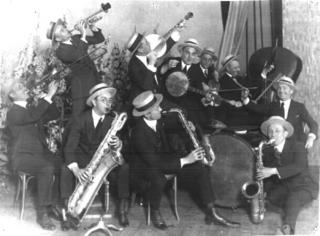Exotica through the years, Part 1
That branch of pop music known as "exotica" began with Martin Denny. And rock and roll was invented by Elvis. And The Sting reintroduced ragtime to the American public.
Now you're ready to start your career as a pop music journalist. Have fun.
Meanwhile, back at the blog, we will examine the history of exotica a little more closely. We'll start by traveling back to 1956, where we'll visit a few record stores and grab some Sun Elvis 78s and assorted blues and rockabilly sides to sell when we get back to the future. Once we've done that, we'll zip back 35 more years to 1921, where the sounds of Max Dolin's Orchestra are ringing forth from a nearby cabinet gramophone:
Si Llego a besarte (Dame un beso) (Bolero Cuban), Orquesta Max Dolin (1921).
"If I Get to Kiss You" is the translation of the first part of that title. Great stuff--Max's band was a rhythmically looser version of Paul Whiteman's, almost. And, speaking of Paul, here's a side by that hard-drinking King of Jazz called Down in Old Havana Town, known to Bix Beiderbecke collectors primarily as a Whiteman side featuring Bix but without a solo (and therefore of no interest). In fact, the side boasts a highly imaginative Ferde Grofe arrangement, interesting rhythm(s), and at least one brief change of meter--from 3/4 to 4/4 (the latter being the time signature of the verse, I'm betting). And great playing, too. But no Bix solo. Maybe I should throw it in a landfill. (Just being sarcastic.)
Down in Old Havana Town (arr: Ferde Grofe), Paul Whiteman and His Orchestra, 1928.
Now let's jump back nine years (bumpy ride, no?) to 1919, the year that Art Hickman began his recording career. If the idea of 1919 exotica seems like too exotic a concept, then give these beautifully-played performances a cyber-spin:
On the Streets of Cairo, Art Hickman and His Orchestra, 1919.
Cairo, Art Hickman and His Orchestra, 1919.

"Someday, guys, they'll call this stuff 'exotica'!"
And we close (for now) with two famous Lecuona numbers--the first by Margarita (Taboo) Lecuona, and the second by the better-known Ernesto (Malaguena, Granada, Andalucia) Lecuona. Jan August, whose Dizzy Fingers didn't get a rave review at this blog, does a terrific job on the Ernesto number.
Babalu (Margarita Lecuona), Jan August, 1951.
Siboney (Ernesto Lecuona), Lenny Dee, 1955.
More exotica-through-the-years to come!
Lee
Now you're ready to start your career as a pop music journalist. Have fun.
Meanwhile, back at the blog, we will examine the history of exotica a little more closely. We'll start by traveling back to 1956, where we'll visit a few record stores and grab some Sun Elvis 78s and assorted blues and rockabilly sides to sell when we get back to the future. Once we've done that, we'll zip back 35 more years to 1921, where the sounds of Max Dolin's Orchestra are ringing forth from a nearby cabinet gramophone:
Si Llego a besarte (Dame un beso) (Bolero Cuban), Orquesta Max Dolin (1921).
"If I Get to Kiss You" is the translation of the first part of that title. Great stuff--Max's band was a rhythmically looser version of Paul Whiteman's, almost. And, speaking of Paul, here's a side by that hard-drinking King of Jazz called Down in Old Havana Town, known to Bix Beiderbecke collectors primarily as a Whiteman side featuring Bix but without a solo (and therefore of no interest). In fact, the side boasts a highly imaginative Ferde Grofe arrangement, interesting rhythm(s), and at least one brief change of meter--from 3/4 to 4/4 (the latter being the time signature of the verse, I'm betting). And great playing, too. But no Bix solo. Maybe I should throw it in a landfill. (Just being sarcastic.)
Down in Old Havana Town (arr: Ferde Grofe), Paul Whiteman and His Orchestra, 1928.
Now let's jump back nine years (bumpy ride, no?) to 1919, the year that Art Hickman began his recording career. If the idea of 1919 exotica seems like too exotic a concept, then give these beautifully-played performances a cyber-spin:
On the Streets of Cairo, Art Hickman and His Orchestra, 1919.
Cairo, Art Hickman and His Orchestra, 1919.

"Someday, guys, they'll call this stuff 'exotica'!"
And we close (for now) with two famous Lecuona numbers--the first by Margarita (Taboo) Lecuona, and the second by the better-known Ernesto (Malaguena, Granada, Andalucia) Lecuona. Jan August, whose Dizzy Fingers didn't get a rave review at this blog, does a terrific job on the Ernesto number.
Babalu (Margarita Lecuona), Jan August, 1951.
Siboney (Ernesto Lecuona), Lenny Dee, 1955.
More exotica-through-the-years to come!
Lee


1 Comments:
Thanks!
"Taboo" and a 1931 version of "Siboney" coming soon!
Lee
Post a Comment
<< Home